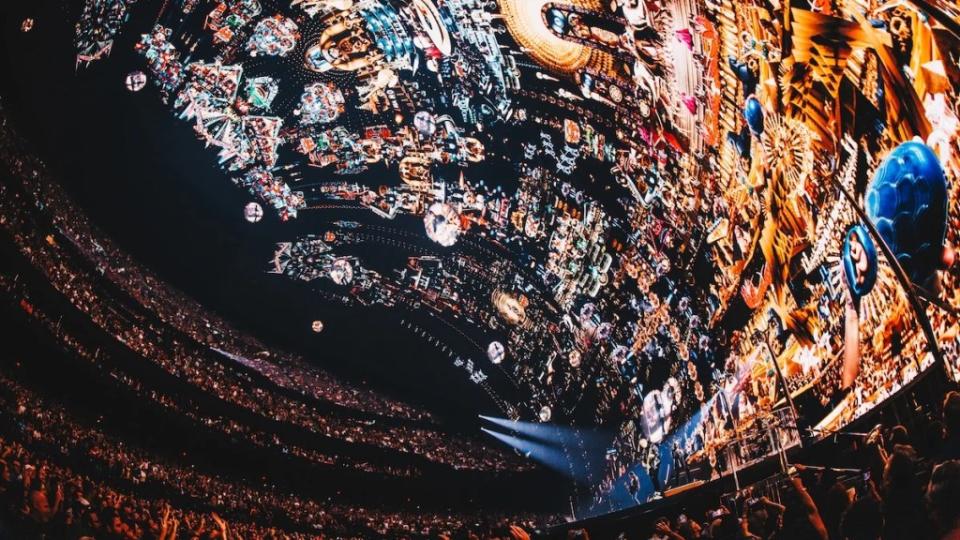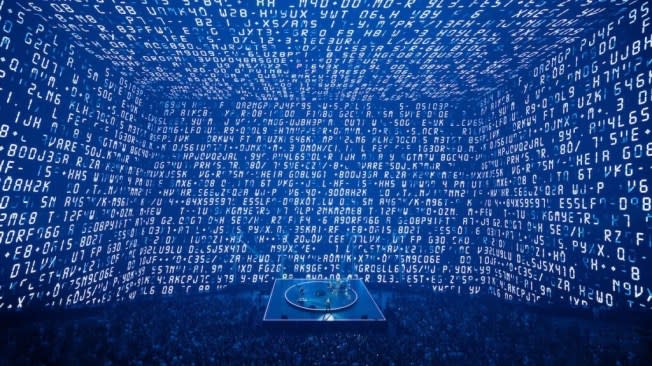U2 in Las Vegas: Looking to the Past, Finding a Crazy Vision of the Future
The first lines of the first song that U2 plays during every one of its shows at the Sphere in Las Vegas are a declaration coming from a guy who’s used to declaring things.
“I’m ready,” shouts Bono from a small, nearly bare stage in the middle of an enormous and often not-at-all-bare space. “I’m ready for the laughing gas.”
And then he really gets to the point. “I’m ready. I’m ready for what’s next.”
In a way, U2 at the Sphere is designed to be the embodiment of that phrase, “what’s next.” At a time when the entertainment industry is trying to figure out what kind of future it has, U2 has parked itself inside a giant ball a few blocks from the Strip, resurrected a 30-year-old album and found a crazy vision of the future that makes perfect sense in a godawful desert mirage of a town.
(Technically, the Sphere is not in Las Vegas but in Paradise, Nevada, because of course it is.)
The U2 show on Friday night was one of three November dates – Nov. 1, 3 and 4 – that ended the first five weeks and 17 shows of U2’s residency at the Venetian hotel’s mind-boggling venue. The band now has a month off, before returning for eight shows in December, three in January and eight in February, plus whatever else they want to add in a venue that might as well have been made for them.
To call the show spectacular feels somehow lacking, particularly in a city where cheap spectacle is the coin of the realm. But even placed alongside other big, lavish concerts with abundant high-tech visuals – shows that include quite a few previous U2 tours – “U2UV,” as this one is called, feels brand new. “You ain’t seen nothing yet,” the venue might as well say as you walk up to it. And really, you ain’t.
This is not exactly a blueprint for where entertainment can go, unless you want to build Spheres in every city. To pull this off, you need money, ambition, hubris, more money, foolhardiness and a little brilliance. And I’m talking about both the people who built the Sphere and the people who filled it with what Hollywood calls “content.”
Darren Aronofsky, by the way, is another of those people. on the nights when U2 isn’t in town, he’s got a 17K sci-fi travelogue called “Postcard From Earth” that plays there and pretty much redefines what immersive cinema can be. “Oppenheimer” in 70mm IMAX may be impressive, but a screen that wraps all the way around you and completely over your head is something else entirely. (It also blows wind in your face and shakes your seat, only one of which Bono can do.)

At any rate, Friday night’s U2 show was, it’s safe to say, not something I would have predicted when I first saw this band at a 1,000-seat club in the San Fernando Valley in March of 1981. Back then, they were making their first trip to Los Angeles and had so few songs that their encore consisted of replaying three numbers they’d already done in the set.
But that baby band (Bono was 20 that night in Reseda, and the Edge was 19) got bigger, in more ways than one. I saw them repeatedly and talked to them quite a bit throughout the 1980s, including at some memorable shows on their breakthrough “Joshua Tree” tour in 1987 and ’88. That tour began and ended in Phoenix, Arizona, about 250 miles across the Mojave and Sonoran deserts from Las Vegas.
At the end of that tour, just after New Year’s Day in 1989, I sat in a Dublin pub with the four members of the band to talk about the two years that had transformed them into the biggest band in the world. “We picked up so much along the way that’s just extra baggage – people and houses and big motorcades and airplanes and helicopters and boats. … We don’t need them. All we need is three-and-a-half minutes. All we can do is simplify, strip away and just make bright, shiny music. Just dream it up.”
What they dreamed up after that wasn’t exactly simplified – instead, it was “Achtung Baby,” the album they’re performing in its entirely every night at the Sphere. The 1991 recording was a deceptive album, noisy and cluttered as it let Bono try on a lounge-lizard character, the Fly, and pretend it’s all about shiny surfaces, sensory overload ands the triumph of facades: “Even Better Than the Real Thing,” as one song title put it.
But the album, recorded in Berlin just after the wall came down, used its shiny veneer of insincerity as a sparkly bit of misdirection to cover a core that was as heartfelt as old U2 songs like “Sunday Bloody Sunday” or “Pride (In the Name of Love).” It was an assault on the senses on one level, but at its heart it was a wrenching look at survival in a fragmenting world.
And the tour that followed, the Zoo TV tour of 1992-93, was by far the least simplified thing U2 had ever done — and one of the best. I got to know them as a club band making its tentative first steps into arenas, and I loved them as they embraced the scale of the “Joshua Tree” tour, but “Zoo TV” was an irresistibly grand statement, and the bigger it got, the better it was. I have vivid memories of the band at Dodger Stadium in 1992, watching smoke pour from the top of huge towers during “Until the End of the World” and thinking I’d never seen them do a better show.
Fast forward 30 years, and what made sense for Berlin in ’93 is perfect for Vegas in ’23. The town was built to enshrine sensory overload, and these days it’s a ridiculous assault on the senses that piles neon on top of glitter, gives it a high-tech sheen and a coat of phony classiness and builds it bigger and flashier and sillier.
Look north up the Las Vegas strip, if you can see past the construction areas and blocked lanes and scaffolding and out-of-order elevators and escalators that make getting anywhere in any way an enormous pain, and you might spot the high-rise hotel with a sign at the top that says “TRUMP.” It’s the least garish thing on the street, as scary as that may be to contemplate.
So if Bono didn’t write the lines “Sunrise like a nosebleed / Your head hurts and you can’t breathe” (from “Trying to Throw Your Arms Around the World”) in this town, he might as well have. And one of the most astounding visuals in a show based on astounding visuals comes when the enormous walls of the venue seem to dissolve so that we’re looking through them toward the Las Vegas Strip as the band plays its new song, “Atomic City.” As they play, the parking lots turn to sand, the buildings come down one by one and the flashy cityscape slowly becomes an empty desert, as it might have been before Bugsy Siegel and his pals got to work here decades ago.

The Sphere, in a way, is the first venue where you don’t bring in the screens and the visual effects; the 20,000-seat arena is the screen, an enveloping interior that can turn into whatever you want at the push of a button. The spectacle of the venue and the show makes those walls of monitors on the Zoo TV tour seem like child’s play as the walls break open and the venue appears to change shape, or when the place is flooded with Elvises – Nicolas Cage’s version, Austin Butler’s version, A.I. versions – during “Even Better Than the Real Thing.”
The stage, meanwhile, is minimal, a flat surface with a turntable that changes color based on the song and on some kind of algorithm developed by Brian Eno to make every show a little different. (Like all things Brian Eno, it’s very cool and I don’t know what the hell the theories that drive it mean.)
It’s easy to put all the focus on the visuals when talking about U2 at the Sphere, but the heart of the band’s music is still beating on “Achtung Baby” classics like “One” (their best song, in my book), “Until the End of the World” and the quartet of lesser-known “Achtung Baby” songs that end that section of the set: the urgency of “Acrobat,” grace of “So Cruel,” brittle yearning of “Ultraviolet (Light My Way)” and haunted brilliance of “Love Is Blindness.”
Friday night’s show included an unexpected dip into the “War” album from 1983, and it was not lost on anybody in the room how timely that was. One song about terrorism and nuclear weapons, “Seconds,” was performed for the first time in 38 years. Another, “Sunday Bloody Sunday,” was done for the first time on this tour, a mild surprise considering it dealt with bombings in Northern Ireland that killed children and civilians, and circles back to the refrain, “How long must we sing this song?”
With songs like those, U2 reached to the past to address the present; within an astounding setting, they also went back to old music while finding a way forward. It brought me back to something Bono said in that pub in Dublin almost 35 years ago: “The future is not to look back,” he said. “The future is to reinterpret the past.”
As they end their first stretch of shows at the Sphere, U2 is reinterpreting the past in a way that looks a lot like a crazy and thrilling kind of future.
The post U2 in Las Vegas: Looking to the Past, Finding a Crazy Vision of the Future appeared first on TheWrap.

